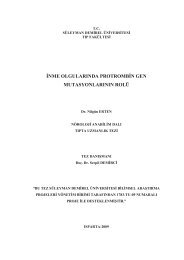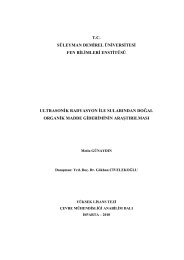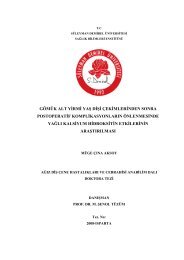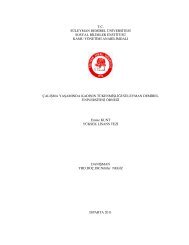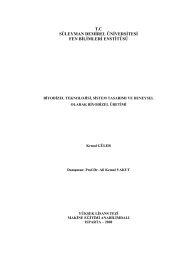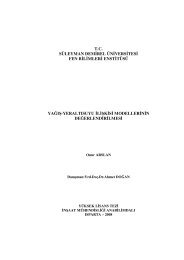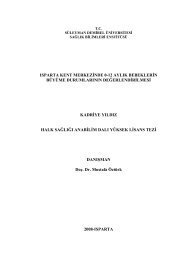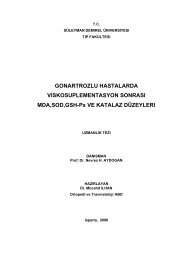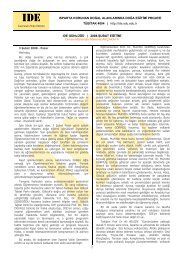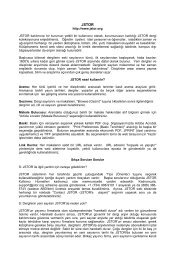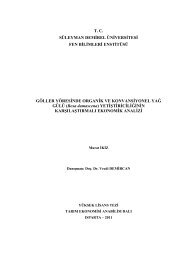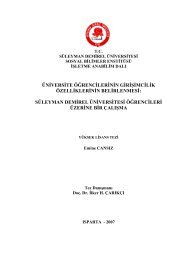Proceedings Book / Bildiri Kitabı - Orman Fakültesi - Süleyman ...
Proceedings Book / Bildiri Kitabı - Orman Fakültesi - Süleyman ...
Proceedings Book / Bildiri Kitabı - Orman Fakültesi - Süleyman ...
You also want an ePaper? Increase the reach of your titles
YUMPU automatically turns print PDFs into web optimized ePapers that Google loves.
2 nd International Non-Wood Products Symposium 8-10 September 2011 - Isparta/TURKEY<br />
1. INTRODUCTION<br />
Private afforestations have become an important<br />
field of activity in Turkish forestry in recent years.<br />
In these practices, the main goals are to increase<br />
the forested land by private initiatives and to<br />
provide local communities with additional sources<br />
of income. Recently, most of these afforestations<br />
are established with income generating species<br />
such as almond (Prunus sp.) and walnut (Juglans<br />
sp.), which produces highly profitable non-wood<br />
forest products for local communities. For the last<br />
decade, there was a considerable increase in the<br />
area of private afforestations, but there are also<br />
some issues which need to be resolved.<br />
2. REGULATIONS ABOUT PRIVATE<br />
AFFORESTATIONS<br />
Private afforestations are carried out according to<br />
Afforestation Regulation No 27215 and Private<br />
Afforestation Circular No 20. These regulations<br />
have been updated several times over the years.<br />
Based on these regulations, private afforestations<br />
can be established by real and legal entities. These<br />
afforestations can be established on forestland,<br />
treasury land or private land. Forest land has to be<br />
unproductive forest tracts or openings if<br />
considered for these afforestations. A minimum of<br />
0.5 ha is allowed on forestland and private<br />
properties, while a minimum of 2 ha is required<br />
for treasury lands. A maximum allowable land<br />
area is 300 ha at one time.<br />
Various species can be used for these<br />
afforestations. On forestlands, main forest tree<br />
species with wood products or secondary species<br />
with non-wood products can be used, in pure or<br />
mixed manner. These include pine (Pinus sp.),<br />
cedar (Cedrus libani), fir (Abies sp.), spruce<br />
(Picea sp.), oak (Quercus sp.), beech (Fagus sp.),<br />
maple (Acer sp.) etc. for main species and walnut,<br />
chestnut (Castanea sativa), pistachio (Pistachia<br />
vera), carob (Ceratonia siliqua), hawthorn<br />
(Creatagus orientalis), almond, laurel (Laurus<br />
nobilis) for income generation species. Medicinal<br />
and aromatic plants can also be used beneath these<br />
species a on these forest lands.<br />
On treasury and private lands, on the other hand,<br />
the same main forest tree species and fruit species<br />
can be used, along with medicinal and aromatic<br />
plant underneath. The main difference is that this<br />
time olive can also be included as income<br />
generation fruit species. In addition, agricultural<br />
products can also be produced on these lands, as<br />
long as they don’t negatively affect the main<br />
species.<br />
These afforestations should be managed by<br />
management plans prepared by private forestry<br />
bureau. Entrepreneurs are apply for a 15-year<br />
credit with low interest rates for fast growing<br />
income generation species, or 30-year credit with<br />
no interest for min tree species with slow growth.<br />
They can use these credits to cover the cost of<br />
fencing, site preparation, planting, seeding, seed,<br />
seedling, scion, and tending. Owners can utilized<br />
the woody and non-wood products they produce<br />
based on these plans.<br />
3. HISTORY OF PRIVATE<br />
AFFORESTATIONS IN TURKEY<br />
Afforestations have been a significant field of<br />
practice in Turkish forestry. By the end of 2008,<br />
significant afforestation activities have been<br />
performed on almost 2 million ha of land by state<br />
forestry authorities (AGM 2009). Several years<br />
ago, a new action plan was also developed to<br />
perform afforestation, erosion control and<br />
rehabilitation activities on another 2.3 million ha<br />
of forest land (AGM 2007).<br />
However, private afforestations are relatively new<br />
field of practice for Turkish forestry. Private<br />
afforestations started to take place in 1986 with<br />
limited interest. By the end of 2000, only about 38<br />
thousand ha of land was assigned to private<br />
afforestations (Konukçu 2000). In terms of<br />
ownership of the land, private afforestations on<br />
forest land contributed to 74 % of the total, 21 %<br />
of it was on treasury lands, and the remaining was<br />
on private land.<br />
With more flexible regulations and allowance of<br />
fruit trees in private afforestations, the interest for<br />
these activities has increased considerable in the<br />
last decade (Figure 1). By the end of 2008, the<br />
area of land allocated for private afforestations<br />
exceeded 80 thousand hectares, and more than half<br />
of the land was established with income<br />
generating species (AGM 2009). These species<br />
included almond, pistachio, walnut, pine and olive<br />
(Table 1). These numbers shows that most<br />
afforestation (% 79) was carried out on forest<br />
lands. In addition, pine and almond contributed to<br />
more than half of the afforestations. Almost all of<br />
the establishments on private (registered) lands<br />
were carried out with almond, pine and walnut.<br />
There is a great enthusiasm and willingness by the<br />
state authorities to encourage private afforestations<br />
323



